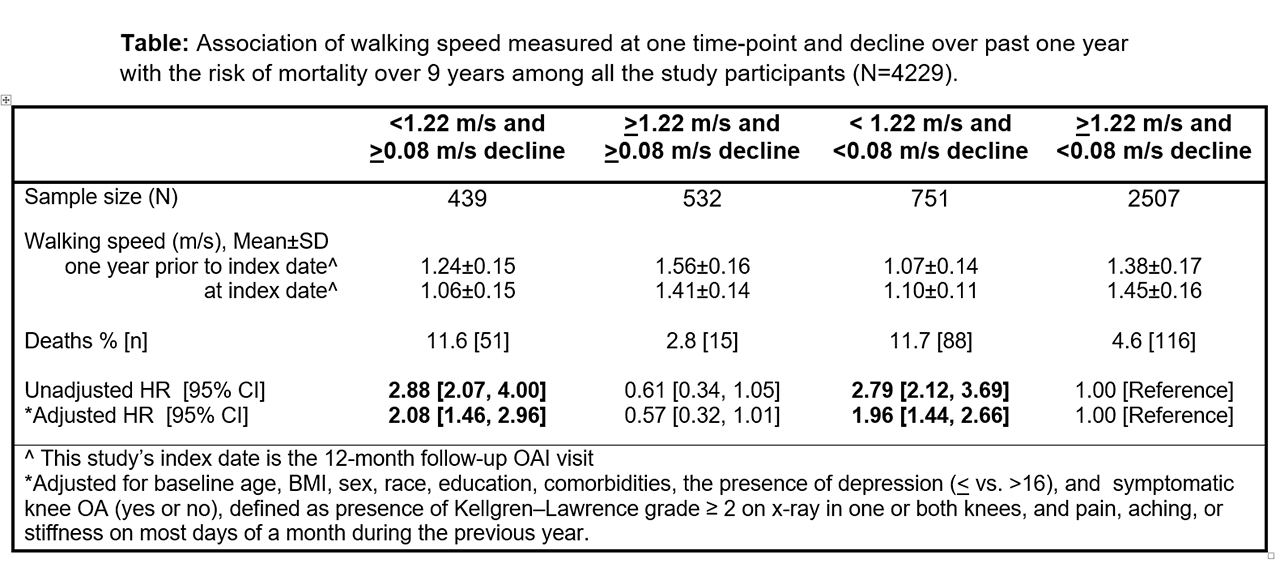Session Information
Session Type: ACR/ARP Abstract Session
Session Time: 11:00AM-12:30PM
Background/Purpose: Slow walking speed (WS) is a risk factor for mortality in well-functioning older adults and speeds slower than (< ) 1.22 meters per second (m/s) are a risk factor for poor health outcomes in knee osteoarthritis (OA). WS is known to decline with age, with some declining faster than other, though it is unclear if the rate of decline in WS is additionally relevant for mortality risk in knee OA. If so, considering the degree of decline over a prior year in addition to the present level of WS may be important. Therefore, the purpose of this study was to investigate whether WS at one time-point, degree of decline in WS over past one year, or both predict mortality risk over 9 years in knee OA.
Methods: We used data from the Osteoarthritis Initiative. WS was measured from a 20-m walk test at baseline and the 12-month visit. The index date for this analysis is the 12-month visit. Walking < 1.22 m/s represents the inability to cross a street with a timed crosswalk, and change >0.08 m/s is considered to be a clinically meaningful decline. We classified people into one of four groups depending on the WS at one time-point (the 12-month visit) and degree of decline over the previous year (from baseline to 12-month visit): [1] < 1.22 m/s and >0.08 m/s decline, [2] at least ( >) 1.22 m/s and >0.08 m/s decline, [3] < 1.22 m/s and < 0.08 m/s decline or [4] >1.22 m/s and >0.08 m/s decline. Mortality was assessed up to 9 years of follow-up. We used Kaplan-Meier curves to determine the survival probability for the four groups. We examined the association of the 4 groups with mortality using Cox proportional hazards regression, adjusting for potential confounders.
Results: Of 4229 participants in the analytic sample (58% female, age 62.3±9.2 years, BMI 28.5±4.8 kg/m2), 6% (n=270) died over 9 years. Groups with WS < 1.22 m/s at one time-point were at higher risk of mortality irrespective of history of decline in WS (Figure). Those walking < 1.22 m/s with and without decline had 108% and 96% greater risk of mortality compared with those walking >1.22 m/s without meaningful decline over previous year (Table). Those walking ≥1.22 m/s with decline had a lower risk of mortality than the group walking ≥1.22m/s without meaningful decline in WS, likely related to the latter having started with a higher WS at baseline.
Conclusion: Walking slower than 1.22 m/s was associated with increased mortality risk, irrespective of degree of decline in WS in adults with knee OA. Those walking at least 1.22 m/s who had a meaningful decline in WS over the prior year, did not have increased risk of mortality, and in fact had nonsignificant lower risk, suggesting a potential threshold effect such that WS assessed at one time-point may be sufficient to gauge mortality risk.
To cite this abstract in AMA style:
Master H, Neogi T, Michael L, Thoma L, Voinier D, Christiansen M, Jakiela J, Neely L, White D. Does the Degree of Decline in Walking Speed Predict Mortality Risk Beyond the Present Level of Walking Speed in Knee Osteoarthritis? [abstract]. Arthritis Rheumatol. 2019; 71 (suppl 10). https://acrabstracts.org/abstract/does-the-degree-of-decline-in-walking-speed-predict-mortality-risk-beyond-the-present-level-of-walking-speed-in-knee-osteoarthritis/. Accessed .« Back to 2019 ACR/ARP Annual Meeting
ACR Meeting Abstracts - https://acrabstracts.org/abstract/does-the-degree-of-decline-in-walking-speed-predict-mortality-risk-beyond-the-present-level-of-walking-speed-in-knee-osteoarthritis/


